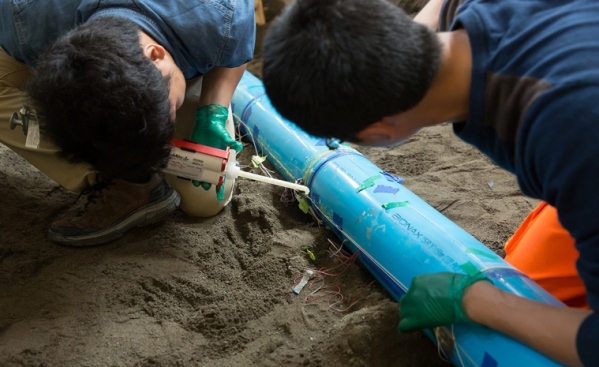U.S. and U.K. university researchers recently conducted a successful trial test at Cornell University (Ithaca, New York) using advanced sensors to measure strain, temperature, movement, and leakage on an underground pipeline.
The sensors, developed by researchers at the University of California, Berkeley (Berkeley, California) and the University of Cambridge (Cambridge, United Kingdom), were installed along a 40-ft (12.2-m) section of a hazard-resilient plastic pipeline being tested for earthquake fault-rupture performance.
According to the research team, it has historically been very difficult to test wireless systems for underground infrastructure in the field—particularly when trying to simulate rare and extreme events, such as earthquakes. However, researchers believe the additional data collected by the advanced sensors could be extremely beneficial by better indicating problems such as corrosion in buried infrastructure.
Case Study Details
In this case, the tested pipeline was produced by IPEX (Oakville, Ontario, Canada). The company used a polyvinyl chloride (PVC) material engineered to stretch, bend, and compress as the pipe withstands extreme ground deformation similar to that which can occur during earthquakes, floods, and construction activity.
Engineers from the schools, IPEX, and other municipalities traveled to Cornell’s Geotechnical Lifelines Large-Scale Testing Facility in Ithaca to watch as the pipeline experienced a simulated fault rupture while buried inside a hydraulically powered split basin filled with 80 tons (72,576 kg) of soil. The observers from municipalities and the pipe company were especially interested in the sensors, according to the researchers, who say the sensors can provide data for not only the infrastructure but also the surrounding environment.
According to the team, the test was the first use of the advanced sensors for monitoring buried infrastructure—and it provided an unprecedented look at the pipe’s ability to elongate and bend while being subject to ground failure. Researchers said the pipe was able to accommodate 50% more ground deformation than the previous pipe design.
New Technologies Used
Several new sensor-related technologies were used as part of the test, the researchers explain, including:
• Distributed strain sensing. In this process, a laser pulse is injected through an optical fiber cable glued to the pipe. By examining the interaction signal that is generated at every point of the fiber, it is possible to obtain strain values continuously along the pipeline, the researchers say.
• Fiber Bragg grating (FBG) sensing. The FBG concept works as a fiber-optic line splits and diffracts light into wavelengths. This allows researchers to monitor bending and axial deformations accurately at discrete points, especially at pipe joints.
• Frequency-domain reflectometry. In this process, metal prongs use an electric field to measure changes in soil moisture and detect leaks. The device is battery powered and can wirelessly transmit data through soil using a coupled magnetic induction and electromagnetic wireless sensor network system.
• Smart joint-opening detection. Small magnets are attached at pipe joint locations. Once a pipe has stretched or compressed to a specific limit, the magnets conjoin to trigger the wireless sensor network to initiate the monitoring.

Data for Infrastructure, Environment
“You can learn something about sources of subsidence, corrosion that affects other structures, or something about the geographic distribution of earthquake or hurricane damage, which then allows you to make improved decisions about emergency response,” says
Tom O’Rourke, a Cornell professor and principal investigator on the project.
“This is about having feedback and intelligence for underground lifeline systems, such as water supplies, electric power, and telecommunications, which provide the services and resources that define a modern city,” he adds. “It’s pretty clear to me that within 20 years, there will be intelligence integrated into every aspect of infrastructure.”
Kenichi Soga, a Berkeley professor and principal investigator for the Berkeley and Cambridge teams, concurred with that assessment.
“The vision we have is that our future infrastructure looks after itself by sensing and adapting to the changing environment,” Soga says.
The researchers say the results could also provide valuable feedback to manufacturers such as the piping company, allowing them to improve performance by advancing the engineering behind new products like the flexible PVC pipe.
Next Research Steps
The first phase of the project was the large-scale sensor test and collection of data, completed at Cornell’s testing facility in June 2017. The next step, the researchers explain, involves excavating the pipeline and analyzing the massive amounts of data collected by the sensors. That process is currently underway and is expected to continue over the coming months.
“It’s going to be game-changing,” says Brad Wham, a geotechnical engineering postdoctoral researcher at Cornell, who adds that some of the sensor devices are capable of recording a thousand measurements or more per second. “We have many, many gigs of data right now for measurements that were previously unattainable.”
Source: Cornell University, www.news.cornell.edu. Contact Tom O’Rourke, Cornell University—Email: TDO1@cornell.edu.